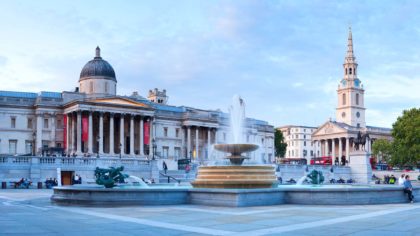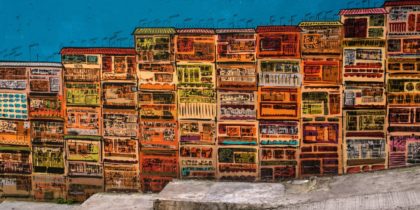When planning your weekend getaway, you jot down the usual on your itinerary: restaurants, museums, spas, trails and vistas. Driving several hours to the middle of nowhere likely isn’t on the agenda — but it should be.
What were once hidden art treasures are quickly becoming must-see attractions, unearthed thanks to adventurous Instagrammers with a tank full of gas. So pack your bags, charge your phone and hit the road to these unique desert destinations.
RELATED: The 7 Coolest Neighborhoods in the U.S., Right Now
Ghosts of Nevada
While there’s more than enough to keep you occupied in Las Vegas, it’s good to get away from the dizzying lights and casino floor clamor. For a change of scenery for the day, head 120 miles northwest to Rhyolite. What was once a booming mining community is now a shell of itself.
After the 1906 San Francisco earthquake disrupted railroad service, many of the townspeople packed up their belongings and went elsewhere. By 1914, power was completely shut off, and the town went dark.
Today, that makes for some fantastic ruins and deserted gems, like Tom Kelly’s Bottle House, a home made from 50,000 bottles.
One of the ghost town’s most famous attractions, however, came long after its residents left. In 1984, Belgian artist Albert Szukalski installed his haunting take on “The Last Supper,” featuring life-size sculptures that look like invisible ghosts draped in sheets. It was the first piece of what would become the Goldwell Open Air Museum, which features various works from international artists.
An hour north of Rhyolite is Goldfield. Like Rhyolite, it was once a thriving boomtown, but as gold deposits declined, so did its population. Less than 300 people call Goldfield home today (some of its inhabitants are rumored to be otherworldly).
While the town serves as a time capsule of the frontier West, it’s also home to one of the quirkiest roadside attractions: the International Car Forest of the Last Church. Established by artists Chad Sorg and Mark Rippie, the Car Forest features more than 40 graffitied cars, trucks and vans, some delicately balanced atop each other, others planted upright into the ground like a row of giant dominoes.
Desert Deliverance
When visiting Palm Springs, it might be nearly impossible to pry yourself from that poolside lounge chair, but there’s a treasure-trove of breathtaking — and bizarre — attractions that await.
Bombay Beach, a mostly abandoned town an hour southeast of Palm Springs, is becoming an art enclave. Deserted homes have been resurrected as public art, like the Toy House, which is covered in large plastic toys, and the all-blue Bombay Beach Opera House, an old home that opens into a small performance space.
Then there’s the Bombay Beach Drive In, a tongue-in-cheek installation that features junked cars lined up as if it were a night at the movies. The town is also home to the Bombay Beach Biennale, which brings in artists from across the country. Some of the art created for the event is permanently installed there, adding new life and vibrance.
A 30-minute drive from Bombay Beach is one of the most peculiar sights you’ll see. Out of the barren desert rises a flourish of greens, blues and pinks that look like a giant pile of melted crayons. Atop the epic mound is a cross with “God Is Love” scrawled beneath it. Welcome to Salvation Mountain, a man-made hill of adobe and straw covered in 100,000 gallons of lead-free paint. Fifty feet tall and 150 feet wide, the mountain was created by Leonard Knight, a local resident who passed away in 2014, as a tribute to his faith. Though it features biblical Scriptures throughout, you don’t need to be a believer to take in this dazzling work of outsider art — all are welcome.
Utopia in the Sun
Arizona is known for its natural beauty, from the Grand Canyon to Monument Valley. But there’s one must-see, man-made wonder that’s lesser known.
Whether you’re reveling in downtown Phoenix’s nightlife or relaxing in Sedona’s mountainous majesty, make sure to save time for Arcosanti. About an hours drive between each city is this architectural marvel designed by the late Paolo Soleri.
Started in 1970, Arcosanti is billed as “an urban laboratory.” Based on Soleri’s concept of arcology, which bridges architecture and ecology, Arcosanti was conceived to be a utopian city where its residents would live in harmony with the natural environment. It’s still under construction.
Currently, Arcosanti boasts several hulking, geometric buildings, including a four-story visitors’ center, a bronze foundry, an amphitheater, workshops and guest housing. Most of the structures look futuristic, like something you’d expect to see in “Blade Runner 2049.” If you’ve ever wanted to step inside of a science fiction movie, this is your chance.




